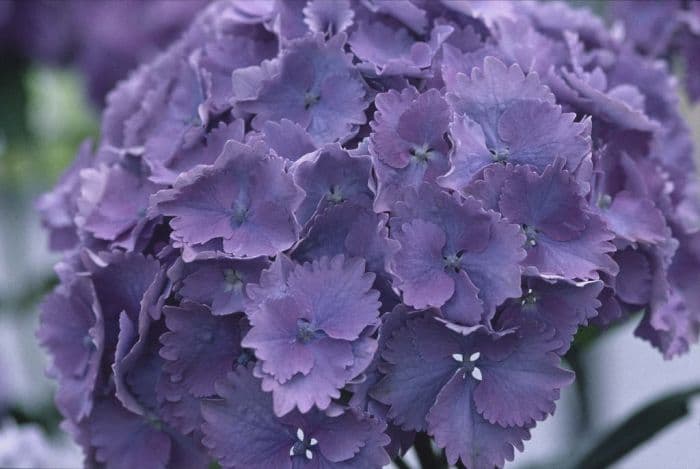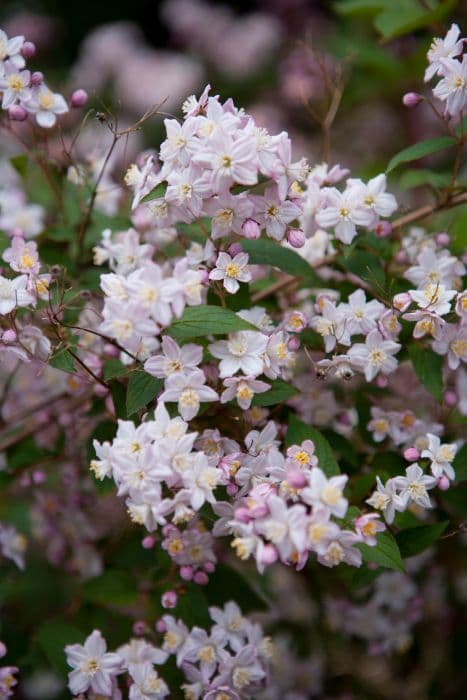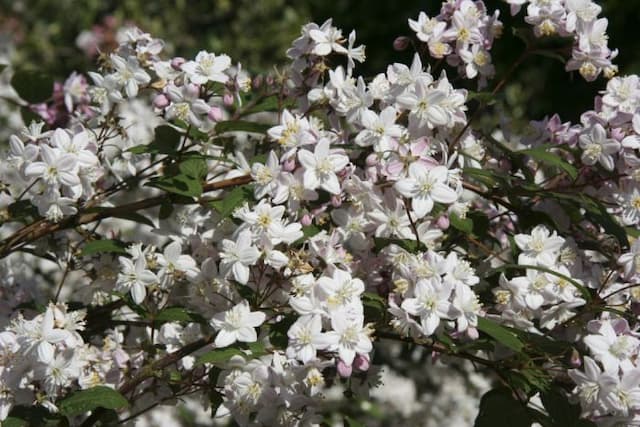Bigleaf Hydrangea Hydrangea macrophylla 'Europa' (H)

ABOUT
The plant commonly known as Hydrangea 'Europa' is a visually striking deciduous shrub noted for its large, luxuriant flower heads and robust foliage. The flowers exhibit a classic mophead form, which means they cluster together creating large, almost spherical balls of blooms. The color of the blossoms can range from a deep pink to a bluish-purple, depending on the soil acidity. In more acidic soils, the flowers take on their blue hues, while in neutral to alkaline soils, they display the pinker tones. Surrounding the flamboyant flowery display are sizable, ovate leaves that appear in a bright green shade. The leaves are somewhat shiny, creating a luscious backdrop for the vibrant flowers. Throughout their blooming period, the flowers present an eye-catching show that can last from early summer through late fall, depending on the local climate and conditions. As the season progresses, the color of the blooms may deepen or fade, adding to the dynamic display of the hydrangea. Once the flowering season concludes, the plant's foliage continues to provide a dense, green presence in the garden until the chill of winter brings about its dormancy. The overall impression of Hydrangea 'Europa' is one of bountiful blooms and a lush, leafy structure that makes it a favorite among gardeners looking for a splash of color and an element of classic garden beauty.
About this plant
 Names
NamesFamily
Hydrangeaceae.
Synonyms
Bigleaf Hydrangea, French Hydrangea, Lacecap Hydrangea, Mophead Hydrangea, Penny Mac, Hortensia.
Common names
Hydrangea macrophylla 'Europa'.
 Toxicity
ToxicityTo humans
The Hydrangea, commonly referred to by its species name Hydrangea macrophylla, contains cyanogenic glycosides, which are substances that can release cyanide when chewed or digested. Ingesting parts of the Hydrangea can potentially lead to poisoning. Symptoms of Hydrangea poisoning in humans might include nausea, vomiting, stomach pain, diarrhea, and in severe cases, respiratory issues due to the cyanide that is released. It's important to exercise caution and avoid ingesting this plant or any of its parts.
To pets
Similar to humans, Hydrangeas also pose a toxic risk to pets if ingested. The Hydrangea contains compounds that can release cyanide into the body. Symptoms of poisoning in pets can include upset stomach, vomiting, and diarrhea, and in more severe instances, lethargy and depression can occur due to cyanide toxicity. As with any poisonous plant, pet owners should guard against allowing their animals to ingest parts of the Hydrangea plant.
 Characteristics
CharacteristicsLife cycle
Perennials
Foliage type
Deciduous
Color of leaves
Green
Flower color
Pink
Height
4-6 feet (1.2-1.8 meters)
Spread
4-6 feet (1.2-1.8 meters)
Plant type
Shrub
Hardiness zones
5-9
Native area
Japan
Benefits
 General Benefits
General Benefits- Ornamental Appeal: Hydrangeas are known for their large, showy flower heads that come in a variety of colors, making them a popular choice for ornamental gardens.
- Long Blooming Period: They typically have a long blooming season that lasts from early summer to fall, providing extended visual interest.
- Shade Tolerance: Hydrangeas can thrive in partial shade, making them versatile for different garden locations.
- Soil pH Indicator: The flower color can be influenced by the soil pH, which makes them useful for gardeners to determine the acidity or alkalinity of their soil.
- Attracts Pollinators: Their flowers are attractive to bees and butterflies, which helps pollinate other plants in the garden.
- Can Be Dried: The flowers are excellent for drying and can be used in long-lasting floral arrangements.
- Seasonal Color Variation: The flowers may change color as they age, adding variety and interest to the landscape.
 Medical Properties
Medical PropertiesThis plant is not used for medical purposes.
 Air-purifying Qualities
Air-purifying QualitiesThis plant is not specifically known for air purifying qualities.
 Other Uses
Other Uses- Changing Soil pH Indicator: Hydrangea can be used as a natural pH indicator for soil by observing the color change in the blooms, which vary from pink to blue depending on the pH level of the soil.
- Rust Dye for Fabrics: The leaves and blooms of the Hydrangea can be used to produce a rust-brown dye for dyeing fabric or yarn when processed properly.
- Pressed Flower Art: The blooms of Hydrangea are often dried and pressed to create botanical art pieces due to their intricate structures and varied colors.
- Photography Subject: Hydrangea flowers, with their large and colorful inflorescences, are popular subjects for photographers and artists looking for natural beauty.
- Piñatas and Paper Craft: The dried flowers of Hydrangeas can be incorporated into paper crafts and even used to decorate piñatas for their ornamental value.
- Colorful Mulch: Dried and crushed Hydrangea petals can be used to add color to mulch, enhancing the appearance of garden beds organically.
- Seasonal Celebrations: Hydrangeas are often used in floral arrangements for weddings and other celebrations due to their opulent, lush blooms and symbolic meanings.
- Bookmark Creation: Thin sections of Hydrangea petals can be laminated to create unique and decorative bookmarks.
- Art and Craft Inspiration: The varied colors and patterns of Hydrangea petals can be used as inspiration for art projects, including watercolor paintings and textile designs.
- Ice Bowl Decorations: Frozen into ice bowls, Hydrangea blossoms add an elegant touch to chilled dishes or punch bowls at summer events.
Interesting Facts
 Feng Shui
Feng ShuiThe hydrangea is not used in Feng Shui practice.
 Zodiac Sign Compitability
Zodiac Sign CompitabilityThe hydrangea is not used in astrology practice.
 Plant Symbolism
Plant Symbolism- Gratitude: Hydrangeas often symbolize heartfelt emotions and can be given to express gratitude for understanding and appreciation.
- Apology: Giving hydrangeas can also symbolize an apology, perhaps because they are lush and full, representing abundance and a willingness to make amends.
- Heartlessness: In some cultures, hydrangeas have a more negative connotation, symbolizing frigidity or heartlessness, possibly due to an old Victorian language of flowers.
- Vanity: The showy nature of the hydrangea blooms has led to its association with vanity and boastfulness.
- Fourth Wedding Anniversary: Hydrangeas are commonly used as an emblem for the fourth wedding anniversary, symbolizing appreciation and lasting bonds.
- Abundance: The lush, full form of the hydrangea bloom represents abundance and prosperity.
 Water
WaterBigleaf Hydrangeas should be watered deeply, aiming to keep the soil moist but not waterlogged. They typically require about 1 inch of water per week, whether through rainfall or manual watering. During hot or dry spells, you might need to water two to three times per week, ensuring that each time you provide enough water to penetrate the root zone. It is best to water the plants in the morning to reduce evaporation and lower the risk of fungal diseases. Use a soaker hose or drip irrigation to deliver water directly to the base of the plant, avoiding wetting the leaves.
 Light
LightBigleaf Hydrangea thrives in morning sunlight and afternoon shade. The best spot for this plant is an area where it can get bright, indirect light for most of the day. Too much direct sun can lead to leaf scorch, while too little light can reduce blooming. An eastern exposure with morning light or a location with filtered light, such as under a deciduous tree, is ideal.
 Temperature
TemperatureBigleaf Hydrangeas prefer moderate temperatures and will grow in USDA zones 5-11. They can handle a minimum winter temperature of about 0 degrees Fahrenheit but do best between 65 to 75 degrees Fahrenheit. Summer temperatures above 80 degrees Fahrenheit can stress the plant, so it's important to provide adequate watering during these times.
 Pruning
PruningBigleaf Hydrangeas should be pruned after they bloom, around late summer or early fall, to avoid cutting off next year's buds. Prune to remove dead or old wood and to shape the plant, focusing on cutting above the new bud growth. Pruning encourages healthy growth and more prolific blooms.
 Cleaning
CleaningAs needed
 Soil
SoilThe best soil mix for growing the common Bigleaf Hydrangea is an evenly moist, well-draining, rich garden soil with organic matter. The ideal pH for this variety is slightly acidic to neutral, targeting a pH range of 5.5 to 7. To achieve this, blend peat moss, compost, and a general-purpose garden soil or potting mix. Adding elemental sulfur can help in lowering the pH if needed.
 Repotting
RepottingBigleaf Hydrangeas should be repotted every 2-3 years to prevent becoming root-bound and to replenish nutrients in the soil. Choose a container only one size larger than the existing one to avoid overwatering issues. The best time to repot is late winter or early spring before new growth begins.
 Humidity & Misting
Humidity & MistingBigleaf Hydrangeas prefer high humidity conditions, ideally between 60-70%. If humidity levels in the environment are lower, especially indoors, it can be beneficial to use a humidifier or place a water tray near the plant to maintain the required humidity levels.
 Suitable locations
Suitable locationsIndoor
Place in bright, indirect light and ensure high humidity.
Outdoor
Plant in partial shade, shelter from harsh sun.
Hardiness zone
6-9 USDA
 Life cycle
Life cycleThe common Hydrangea, including the 'Europa' cultivar, typically follows a perennial life cycle, starting with germination from seed or propagation through cuttings, whereupon shoots emerge and develop into young plants. In spring, these young plants grow rapidly, sprouting large, broad leaves and eventually, in early to mid-summer, they produce clusters of flowers that can be blue, pink, or purple, depending on soil pH. After blooming, the flowers may persist on the plant and gradually dry out, often remaining decorative through autumn and into winter. Throughout the growing season, the plant will undergo vegetative growth, expanding its root system and foliage. As temperatures drop in late fall and winter, the Hydrangea enters a period of dormancy, with above-ground parts dying back, while the roots remain alive underground. In the following spring, the plant will resume growth from the existing root structure, repeating the cycle.
 Propogation
PropogationPropogation time
Spring to Early Summer
Propogation: The Hydrangea macrophylla 'Europa', commonly referred to as the Bigleaf Hydrangea, is typically propagated through softwood cuttings. The prime time to take these cuttings is in late spring or early summer, when the plant's new growth is still tender but mature enough to handle cutting and rooting. A popular method involves selecting a healthy, non-flowering shoot and cutting a 4 to 6 inch (10 to 15 cm) piece just below a leaf node. The lower leaves are removed and the cut end is dipped in rooting hormone to promote root development. The cutting is then planted in a moist potting mix, ensuring at least one set of nodes is buried where roots can form. It's important to maintain high humidity around the cutting, often achieved by placing a plastic bag or dome over the pot. The cutting should root within 4 to 8 weeks.







![Hydrangea [Early Sensation]](/_next/image?url=https%3A%2F%2Fplants-admin.emdemapps.com%2Fimages%2Fplants%2F%2Fimages%2F604b6150338db.png&w=640&q=75)

